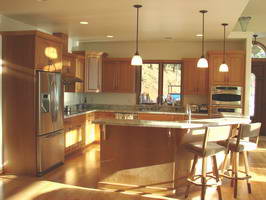Question – Using CFLs Rather Than Incandescent Bulbs
 '; ';
|
Can I use a higher watt CFL than the fixture recommends? © By: Dave Rongey |
I just installed a ceiling fan that calls for 2-40W max B base bulbs. Rather than use incandescent bulbs I thought I’d use CFL’s. I bought 9W bulbs because they are supposed to be a substitute for 40W incandescent bulbs, but there just isn’t enough light. I know that I can’t use higher wattage incandescent bulbs, but what about CFL’s?
I got this info off the GE site, but am still a little skeptical, I don’t want any problems later. “Because the wattage of a CFL bulb is much lower than that of an incandescent, you can use higher wattage CFL giving you the equivalent light of a higher wattage incandescent. For example: If your fixture says not to exceed 60 watts, you can use a 15 watt CFL to get the same amount of light as an incandescent bulb or use up to a 42 watt CFL and increase the amount of light.”
Do you agree with this information and if so, what would the max. wattage be of each of the two CFL’s I could use without causing any problems?
By the way, exactly what damage/harm does it cause to use higher wattage than the maximum recommended?
[ad#block]We have CFL’s in our ceiling fans and have reduced our electric bill and receive more light output as a result.
The Watt limitation is mainly to prevent the lamp socket form overheating and causing damage. In some cases I suppose it has to do with enclosure space as well. Fixtures are designed and limited to this heat factor produced by the lamps, which is based upon incandescent lamps – I’m sure we will see new labeling to accommodate CFL’s.
CFL’s should not be used in totally enclosed fixtures.
Read all the Specifications that comes with the CFL.
Do not use Dimmer Switches on CFL’s unless they state that they are designed for your type of dimmer.
The following may also be helpful for you:
|
|
Be Careful and Be Safe - Never Work on Energized Circuits!
Consult your Local Building Department about Permits and Inspections for all Electric Wiring Projects.
More articles about Electrical Parts Questions and Home Electrical Wiring: |
|
| « Previous | Next » |
How to Add a Light Fixture |
Question – There is Power Going to the Fixture, But it Still Isn’t Working |














